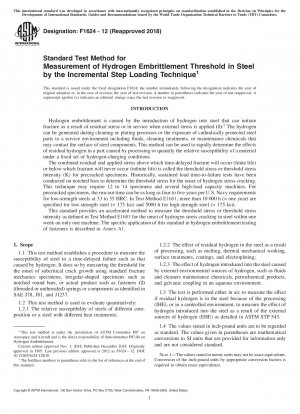ASTM F1624-12(2018)
Standard Test Method for Measurement of Hydrogen Embrittlement Threshold in Steel by the Incremental Step Loading Technique
- Standard No.
- ASTM F1624-12(2018)
- Release Date
- 2018
- Published By
- American Society for Testing and Materials (ASTM)
- Latest
- ASTM F1624-12(2018)
- Scope
- 1.1 This test method establishes a procedure to measure the susceptibility of steel to a time-delayed failure such as that caused by hydrogen. It does so by measuring the threshold for the onset of subcritical crack growth using standard fracture mechanics specimens, irregular-shaped specimens such as notched round bars, or actual product such as fasteners (2) (threaded or unthreaded) springs or components as identified in SAE J78, J81, and J1237. 1.2 This test method is used to evaluate quantitatively: 1.2.1 The relative susceptibility of steels of different composition or a steel with different heat treatments; 1.2.2 The effect of residual hydrogen in the steel as a result of processing, such as melting, thermal mechanical working, surface treatments, coatings, and electroplating; 1.2.3 The effect of hydrogen introduced into the steel caused by external environmental sources of hydrogen, such as fluids and cleaners maintenance chemicals, petrochemical products, and galvanic coupling in an aqueous environment. 1.3 The test is performed either in air, to measure the effect if residual hydrogen is in the steel because of the processing (IHE), or in a controlled environment, to measure the effect of hydrogen introduced into the steel as a result of the external sources of hydrogen (EHE) as detailed in ASTM STP 543. 1.4 The values stated in inch-pound units are to be regarded as standard. The values given in parentheses are mathematical conversions to SI units that are provided for information only and are not considered standard. NOTE 1—The values stated in metric units may not be exact equivalents. Conversion of the inch-pound units by appropriate conversion factors is required to obtain exact equivalence. 1 This test method is under the jurisdiction of ASTM Committee F07 on Aerospace and Aircraft and is the direct responsibility of Subcommittee F07.04 on Hydrogen Embrittlement. Current edition approved Nov. 1, 2018. Published December 2018. Originally approved in 1995. Last previous edition approved in 2012 as F1624 – 12. DOI: 10.1520/F1624-12R18. 2 The boldface numbers in parentheses refer to the list of references at the end of this standard. Copyright © ASTM International, 100 Barr Harbor Drive, PO Box C700, West Conshohocken, PA 19428-2959. United States This international standard was developed in accordance with internationally recognized principles on standardization established in the Decision on Principles for the Development of International Standards, Guides and Recommendations issued by the World Trade Organization Technical Barriers to Trade (TBT) Committee. 1 1.5 This standard does not purport to address all of the safety concerns, if any, associated with its use. It is the responsibility of the user of this standard to establish appropriate safety, health, and environmental practices and determine the applicability of regulatory limitations prior to use. 1.6 This international standard was developed in accordance with internationally recognized principles on standardization established in the Decision on Principles for the Development of International Standards, Guides and Recommendations issued by the World Trade Organization Technical Barriers to Trade (TBT) Committee.
ASTM F1624-12(2018) Referenced Document
- ASTM A490 Standard Specification for Quenched And Tempered Alloy Steel Bolts For Structural Steel Joints
- ASTM A574 Standard Specification for Alloy Steel Socket-Head Cap Screws*, 2021-12-01 Update
- ASTM B602 Standard Test Method for Attribute Sampling of Metallic and Inorganic Coatings
- ASTM E1681 Standard Test Method for Determining a Threshold Stress Intensity Factor for Environment-Assisted Cracking of Metallic Materials
- ASTM E29 Standard Practice for Using Significant Digits in Test Data to Determine Conformance with Specifications
- ASTM E399 Standard Test Method for Plane-Strain Fracture Toughness of Metallic Materials
- ASTM E4 Standard Practices for Force Verification of Testing Machines
- ASTM E6 Standard Terminology Relating to Methods of Mechanical Testing
- ASTM E8 Standard Test Methods for Tension Testing of Metallic Materials
- ASTM E812 Standard Test Method for Crack Strength of Slow-Bend Precracked Charpy Specimens of High-Strength Metallic Materials (Withdrawn 2005)
- ASTM F2078 Standard Terminology Relating to Hydrogen Embrittlement Testing*, 2022-05-01 Update
- ASTM F519 Standard Test Method for Mechanical Hydrogen Embrittlement Evaluation of Plating Processes and Service Environments
- ASTM F606 Standard Test Methods for Determining the Mechanical Properties of Externally and Internally Threaded Fasteners, Washers, and Rivets
- ASTM G129 Standard Practice for Slow Strain Rate Testing to Evaluate the Susceptibility of Metallic Materials to Environmentally Assisted Cracking*, 2024-04-20 Update
- ASTM G5 Standard Reference Test Method for Making Potentiostatic and Potentiodynamic Anodic Polarization Measurements
ASTM F1624-12(2018) history
- 2018 ASTM F1624-12(2018) Standard Test Method for Measurement of Hydrogen Embrittlement Threshold in Steel by the Incremental Step Loading Technique
- 2012 ASTM F1624-12 Standard Test Method for Measurement of Hydrogen Embrittlement Threshold in Steel by the Incremental Step Loading Technique
- 2009 ASTM F1624-09 Standard Test Method for Measurement of Hydrogen Embrittlement Threshold in Steel by the Incremental Step Loading Technique
- 2006 ASTM F1624-06 Standard Test Method for Measurement of Hydrogen Embrittlement Threshold in Steel by the Incremental Step Loading Technique
- 2000 ASTM F1624-00 Standard Test Method for Measurement of Hydrogen Embrittlement Threshold in Steel by the Incremental Step Loading Technique
